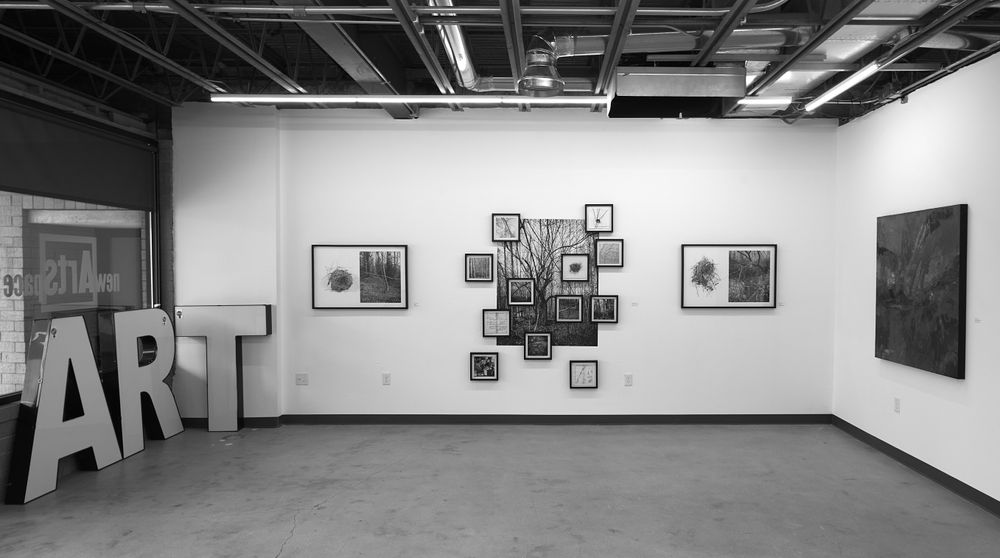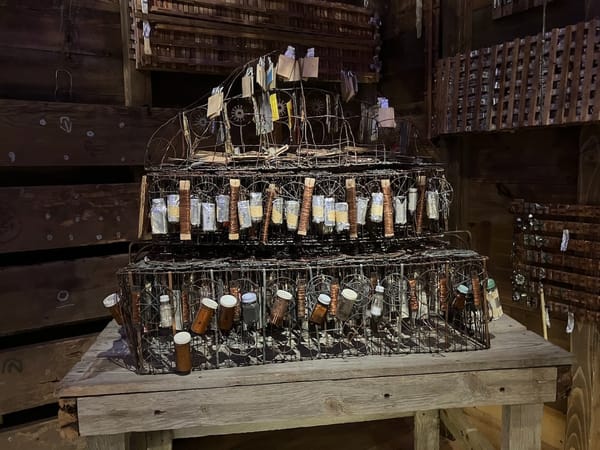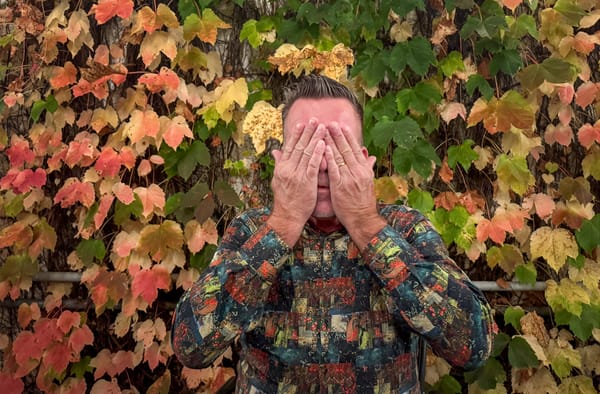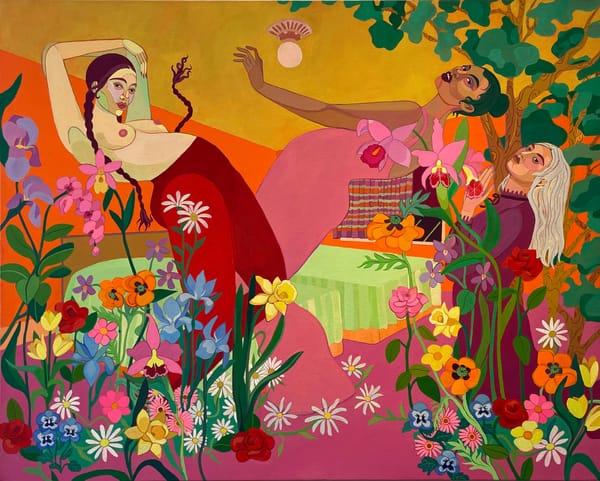Exhibition Review: Newyear:newART II
Newyear:newART II at newARTSpace, De Pere, Wis.
Newyear:newART II is the second exhibition for newARTSpace–a contemporary gallery located in De Pere, Wisconsin–run by artists Terri Warpinski and David Graham. Nine regional artists are represented in the exhibition, with work including drawings, paintings, photography, site-specific installation, and furniture. The show ran from March 10th to April 22nd, 2022. It is archived on the gallery’s website and recorded artist interviews on YouTube; links to these resources are found at the end of this review.
The exhibition begins on the exterior windows facing North Broadway, enticing the locals walking by the front of the gallery on their way to get some ramen or a coffee. Unfortunately, I came in from a side hallway between other small businesses and the gallery–missing that experience. Usually, one entrance isn’t more appropriate than the other; however, in an exhibition that contains work that is often describing the sharing of–and at times conflict over–our environment, contemplating how a contemporary art gallery fits into a neighborhood and enticing the locals so directly, makes this different. These artists have something to say, and Warpinski and Graham have created a much-needed environment for their voices.
The start of the dialogue, affixed to those large street-side windows, is the white vinyl lettering portion of Carol Emmons’ mixed-media installation Causae et Curae. Blocks of text, alternating with which side of the panes of glass they are adhered to (sometimes they would appear in reverse), are passages written over the centuries. Words from Boccaccio’s The Decameron (1353) are placed in proximity to “The Life of a Virus” by Javier Sinay (2020). Time is compressed in a tale that we have become too familiar with. An example of these quotes being:
In the memories of those who lived through them, the grim days of plague do not stand out like vivid flames, ravenous and inextinguishable, beaconing a troubled sky, but rather like the slow, deliberate progress of some monstrous thing crushing out all upon its path.
–Albert Camus The Plague (1947)
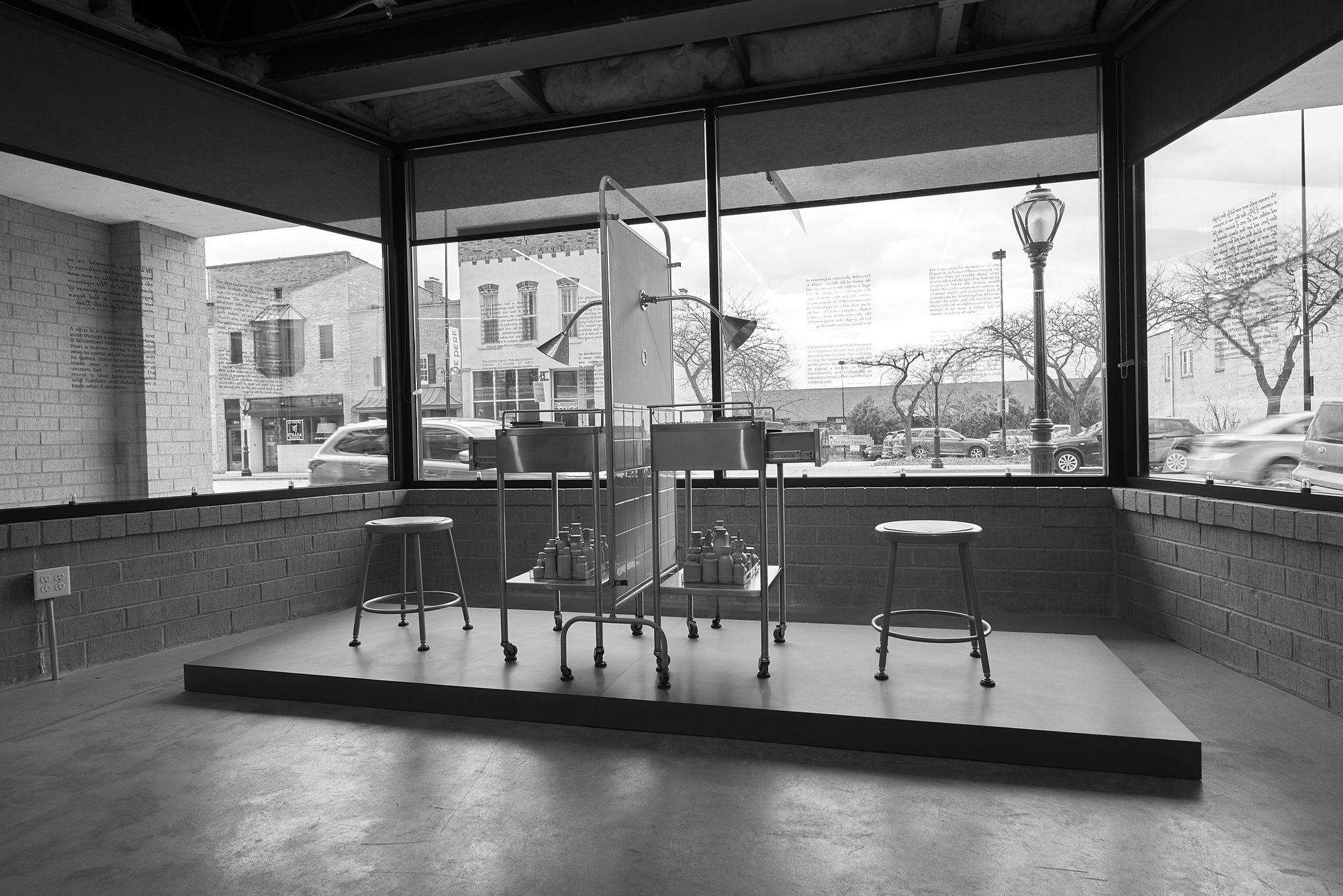
Emmons’ installation includes two identical stainless steel rolling stands, each with a singular metal pull drawer and accompanying stool, separated by a narrow partition, also on wheels, with a vintage light green tile bottom and matching green panel top–an antiseptic medical feel. On either side of the partition, and at equal height, there are reaching metal gooseneck arms, ending in a funnel shape that seems like it could be a light source, but without a bulb present, they take on something more sinister and Kafkaesque. They look like something is meant to be passed through, from one side of the partition to the other. It is unclear what that is, as they do not seem to be for speech. Placed on top of each stand is an artist-created book, accessible to be read, affixed by a chain, and comprised of maladies described in text and visuals–archaic methods of prevention and curation. The pages may be opaque or translucent, the text potentially seen in reverse. One reads in script: Treatment. For the infirmities mentioned, the prescribed remedies that were recommended by God will either cure human beings or they will die, or God does not want them to be cured. There is a section on hair loss, on “Headache from black bile,” and another on migraines. On the low shelf of each of these stands are dozens of unmarked bottles, also colored vintage antiseptic green. And, within each pull drawer, a collection of humorous objects, playfully created from colorful fist-sized balls with spiky adornments appendages made of game pieces, pen nibs, pins, and jelly-like squishy tentacles. Representations of coronaviruses.
Overall, this work speaks of advances in medical treatments… from the barbarous and laughable methods of medieval times to how we treat the omnipresent threat of today–COVID-19. Institutional faith is equally present in the piece–if wheat and poppy oil will not cure the affliction in question, perhaps supreme healing or damnation is the means to an end. And, in the centuries to come (and if there is a possibility to look back on this time), will the methodologies we are using to battle this pandemic seem trite and inconsequential? Will someone read a tweet about drinking bleach and presume that was an accepted treatment? Were we being damned or saved from our behaviors, and does it matter what we try?
Much quieter in approach, yet no less complex, are the drawings of Marjorie Mau. The last time I saw Mau’s works, they were abstract paintings of the Niagara Escarpment, and so these drawings were a surprise to me. These graphite and ink on paper pieces have a distinct precision of a drafter’s hand and a similar subject matter to the analytic cubists–the profile of a vessel. Broken out sections extend out from the implied vessel. According to Mau’s statement, these are representational pottery shards, and are not delineated by shading and space but rather by a cursive script–tight and regular in some instances, blurred and violently erased out in others. That erased text kept me exploring these drawings, which led me to other marks that seemed to be an anomaly: heavy dark lines that lose that drafter’s precision and seemingly become marks made by an aching hand and heart. I felt gravity with that irregular line work.
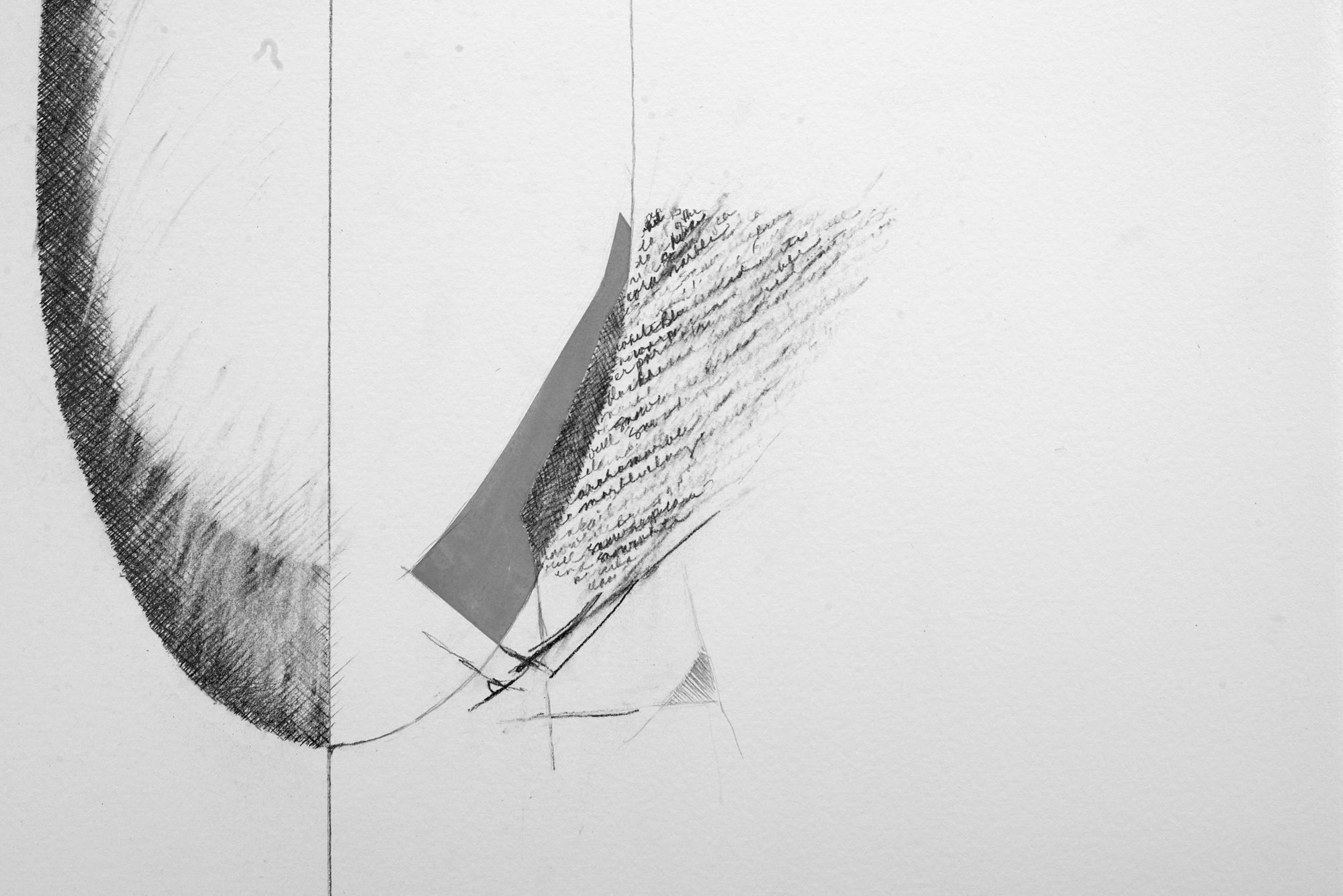
Both Emmons’ and Mau’s pieces speak through text and time. One artist uses quoted passages about plagues and viruses ranging over centuries. The other notes in her statement a parallel between 2,000 year old Greek architectural digs finding grocery lists written on pottery shards, similar in shape to the sketched shapes she delineated in these drawings. And while one of the works is overt with the message of: bad then, bad now… probably going to be bad in the future, I was haunted by the way Mau introduced a deep struggle into my mind with the way she used erasure and irregular line in overall precise drawings. The pieces also speak of recurring battles.
I am not going to assert that this exhibition is all dark, although Karen Stewart’s work–a grid of sixty 6”x4” mixed media pieces meant to be viewed on both sides of their substrates–certainly carries on that feeling. They are an experimental exercise of day, mood, and topic of her experiences during the years of COVID. Along with the main image, each piece has identifying numbers–the date created, confirmed COVID cases, and deaths at the time of COVID. While some of the imagery is specific to the artist’s life, many of the topics are relatable to many people and carries a sentiment of days, months, and years passed as we collectively experienced this worldwide pandemic. This work, collectively titled Pandemic Journey, is a fascinating break from her life-sized contemporary realist paintings and speaks to this collective experience we have had during this worldwide pandemic.
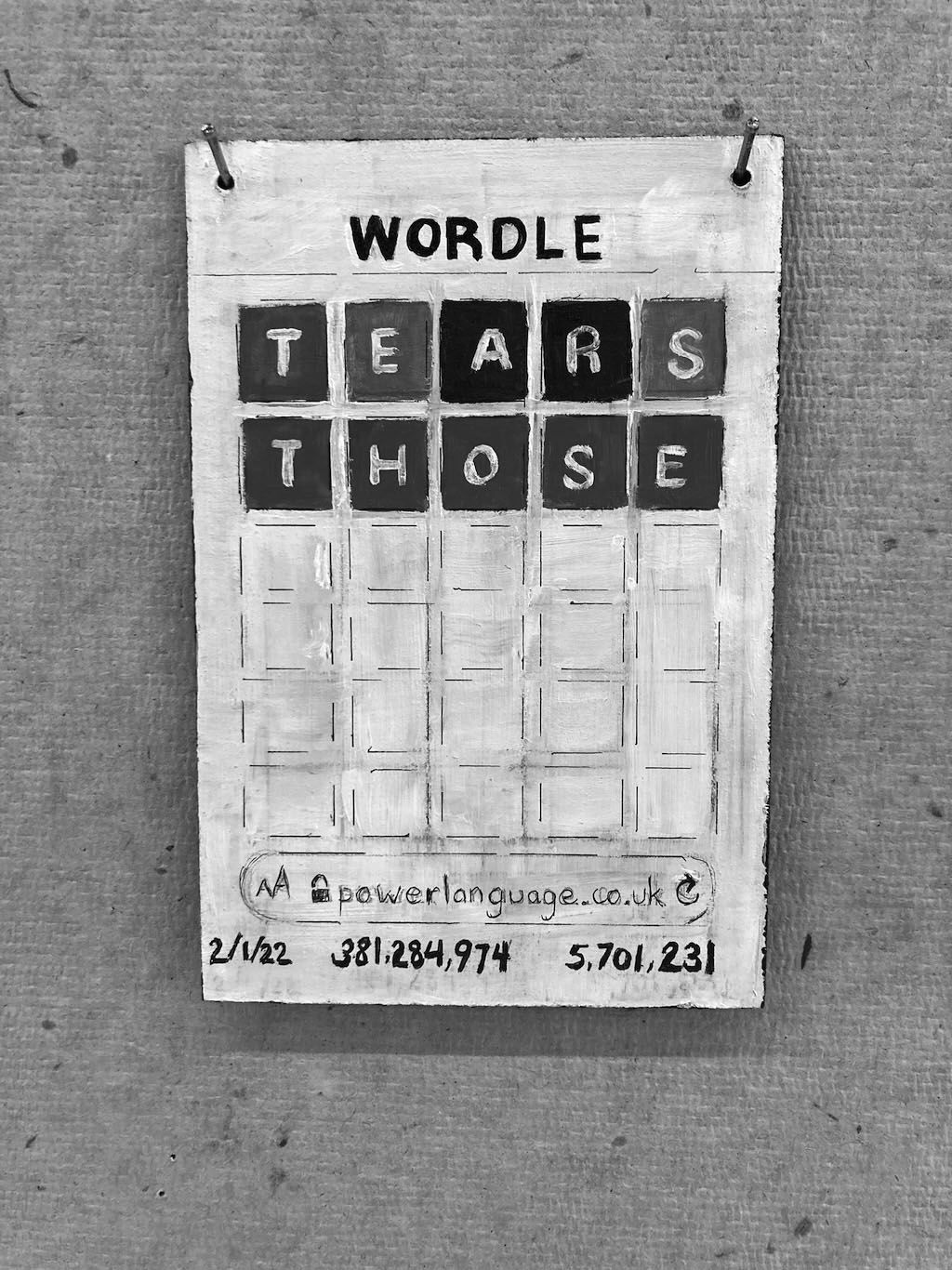
As I wrote earlier, however, the exhibition isn’t all dark. Butterfly Table, by Minkyu Lee, is a sizeable kidney-shaped table constructed of maple and katalox, a deep ebony-colored wood. The toned striations made on the tabletop are striking–long passages of the ebony and honey wood that feel like the pattern of a wild animal. The prominent joining mechanism Lee uses to construct the top–butterfly inlays–are of magnificent craft and artistic beauty in their placement. As a characteristic of his work (whether in wood or ceramic), Lee uses these joiners to provide a rhythmic repetition. However, unlike his faceted ceramic pieces, these butterfly joiners are irregular in their patterning and bring a playful feeling of movement.
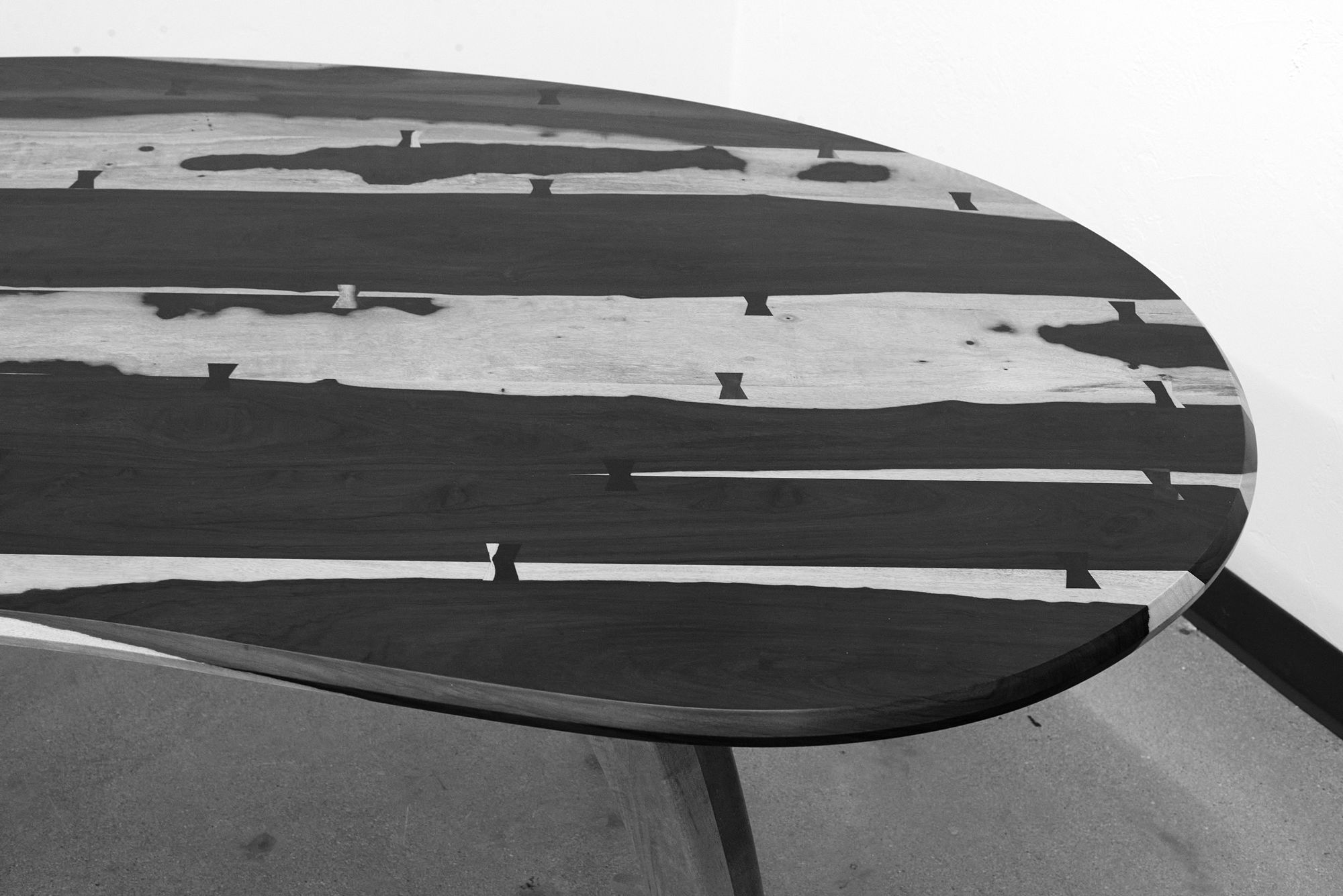
In the artist’s Dwelling 2 and Dwelling 3 photographs, Terri Warpinski juxtaposes the image of a singular tightly woven bird’s nest, visually removed from the natural habitat and isolated on a white background with deep views of the woodlands themselves within each frame. Criss-crossing across the woodland views are long verticals and diagonals created by thin trees in the immediate foreground. While the upright trees are firmly rooted in the ground, it is unclear if the diagonals are branches that have fallen naturally or have been placed by a human hand–yet the result is the same, they form a loose barrier to entry and are in opposition to the densely constructed nests. The nests, a home currently unused, and the barrier, a home protected.
Other artists represented in Newyear:newART II are: Dan Cross, whose paintings from his Beyond the Surface series are a wonderful mixture of textures from the flattest of digital imagery to the viscous, bubbling of a medium resulting in abstractions of Niagara Escarpment full of vitality; Kristy Deetz’ painting Friends Day Hiding, a surrealistic image that has a nostalgic cuteness and joy of a rabbit and cat playing banjo while also hinting at more complicated messaging and experimentations in digital and fiber mediums; Tom Friese’s Black + White 5, an acrylic on paper painting that leans towards a mid-century modernist landscape, playing with scale, subtleties in paint application from pulled thin in what may relate to his method of working as a printmaker to heavy and dimensional; and two small, cold wax paintings by Jane Constable Hostetler–Boxed in, Darkness and Boxed In, Frayed Light. From a short distance, Hostetler’s work has an industrial feel to them; perhaps it is the steely grays and blues. However, when coming closer and meditating on the incised marks surrounding the squares found in the center of the paintings, I felt heavy, human anxiety.

I congratulate Warpinski and Graham for providing this space to these very talented regional artists. newARTSpace has a trendy industrial vibe to it, and it was such a pleasure to be in. And I am in complete agreement with Warpinski that a professional exhibition gallery like this is crucial to the growth of Northeast Wisconsin’s art scene. I hope that many visitors found their way in, in spite of the words of Camus on the window, and were inspired by the work.
Also, get the ramen at Eat30 Café.
newARTSpace is located at 124a North Broadway, De Pere, Wis. 54115
The exhibition Newyear:newART II ran from March 10th–April 22nd, 2022
https://www.newartspace124.com
https://www.youtube.com/channel/UChDYqhSjBObF8W9YW2YbQNg/featured

